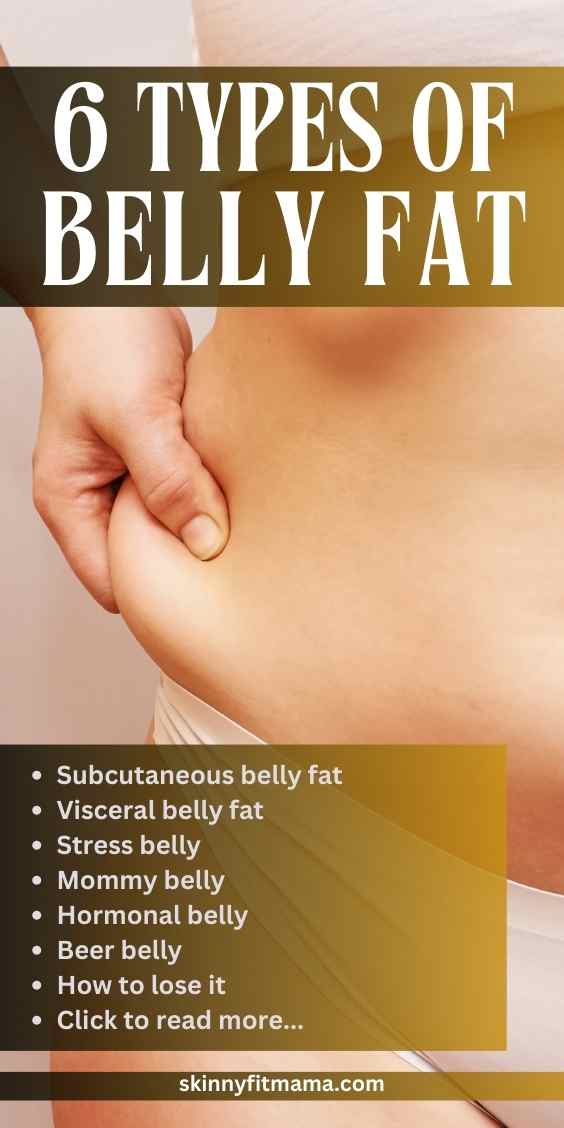Having a little bit of fat around your waist is completely normal, however, having too much fat in your abdomen can lead to health issues. In this post, you will learn more about the different types of belly fat, what the shape and location of your belly fat mean, and how to get rid of it naturally.
Some of the most common causes of belly fat are genetics, hormonal imbalance, consumption of unhealthy foods, and stress. It’s possible to understand what’s causing your belly fat simply by looking at the shape and where it’s located. Once you do, losing it becomes easier.
6 Types Of Belly Fat & Shapes
There are many reasons why you may have belly fat but don’t worry, with the right diet, it can be reversed. According to World Obesity, over 50% of the world’s population will be overweight or obese within the next 12 years thanks to stress and fast food.
That said, you can, however, decide to not be among the 50% by reading this post and taking action. Remember, it’s gonna be hard but absolutely worth it. Now that the pep talk is over, let’s begin! There are 2 main types of belly fat, subcutaneous and visceral belly fat, here’s how they affect you.
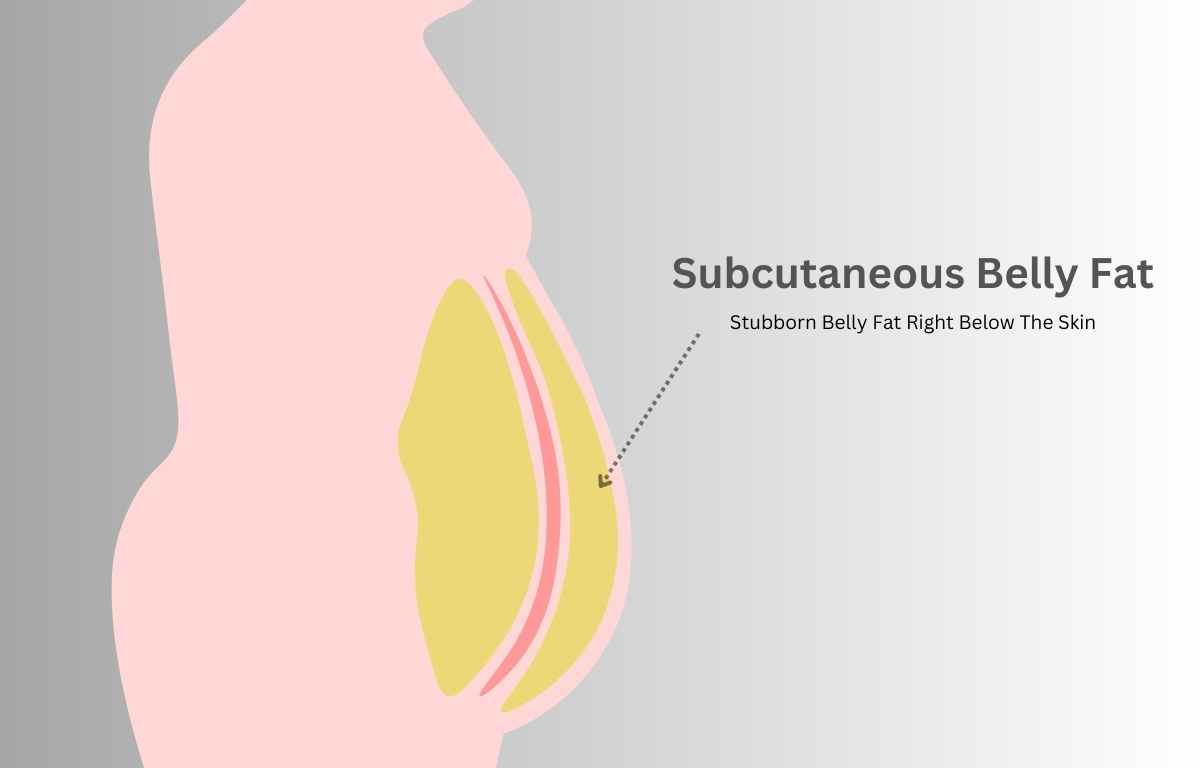
Subcutaneous Belly Fat
So over 90% of the fat found in the body is subcutaneous fat, it is found right under the layer of your skin. This type of fat is not harmful, in fact, it’s actually important because it protects our bones and muscles, connects our blood vessels and nerves, and controls our body temperature.
That said, having too much subcutaneous fat can also mean that you have a good amount of visceral fat as well. Also, having a lot of subcutaneous fat means you don’t have enough muscle mass. Common causes of low muscle mass include inactivity and eating a lot of fatty foods.
Now just to be clear, subcutaneous fat is not dangerous but it is a type of stubborn belly fat that requires a lot of work to get rid of.
Getting Rid Of Subcutaneous Belly Fat
Getting rid of subcutaneous belly fat can be tricky at times and may require some sort of cosmetic surgery or skin tightening procedures afterward. That said, for younger people, simple exercises like walking, cycling, running, swimming, aerobics, palates, and yoga can help tone, and transform most of the fat into muscles.
A healthy diet is also important but drinking enough water and eating foods rich in collagen are required to bring back elasticity into the skin after losing subcutaneous belly fat. Now not everyone will suffer from loose skin, it mostly occurs in people who are obese, lose a lot of weight in a short time frame, older women, or due to pregnancy.
Bottom line: To get rid of subcutaneous belly fat, start with a healthy diet, increase activity by at least an hour a day, drink enough water, and eat collagen-rich foods.
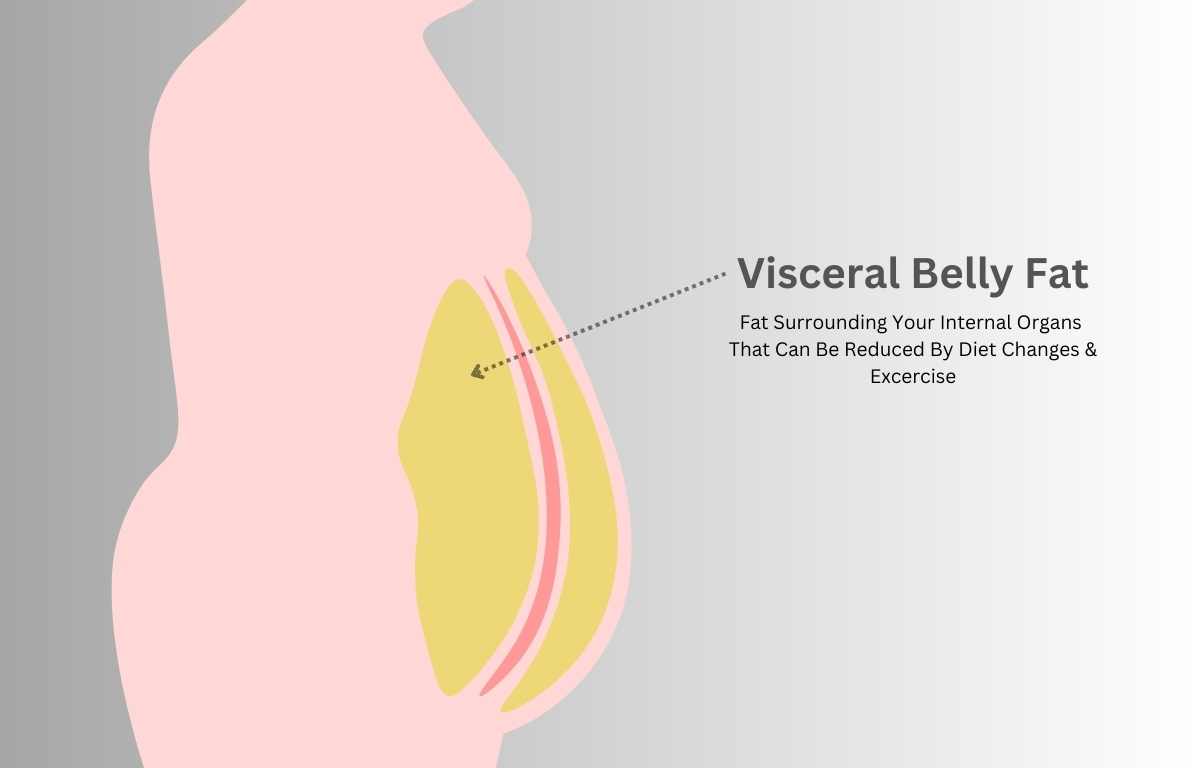
Visceral Belly Fat
So visceral belly fat is a type of fat that is found deep down inside your abdomen and is usually hidden around and between your internal organs. Visceral fat takes up 10% of your overall body fat but that percentage may vary depending on your overall weight and body mass index.
People who are overweight or obese usually tend to have higher amounts of overall visceral fat plus belly fat. Unlike subcutaneous belly fat, visceral belly fat is dangerous and can pose a risk to your health. Continue reading below to learn more about common health issues that are associated with visceral belly fat.
Getting Rid Of Visceral Belly Fat
Compared to subcutaneous belly fat, visceral fat metabolizes faster and is excreted through sweat or urine which makes it easier to lose. With the right diet plan and regular exercising, you can get rid of visceral belly fat completely within 3 months.
Some of the best exercises to lose visceral belly fat includes aerobics, brisk walking, and jogging at least 3 times per week. However, health experts recommend aerobics as the most effective exercise for visceral belly fat. Drinking enough water, reducing stress, eating foods that reduce belly fat, and getting enough sleep are important as well.
Bottom Line: To get rid of visceral belly fat, indulge in aerobic exercise for 1 hour 3 times per week, drink enough water, get enough sleep, and start a healthy diet.
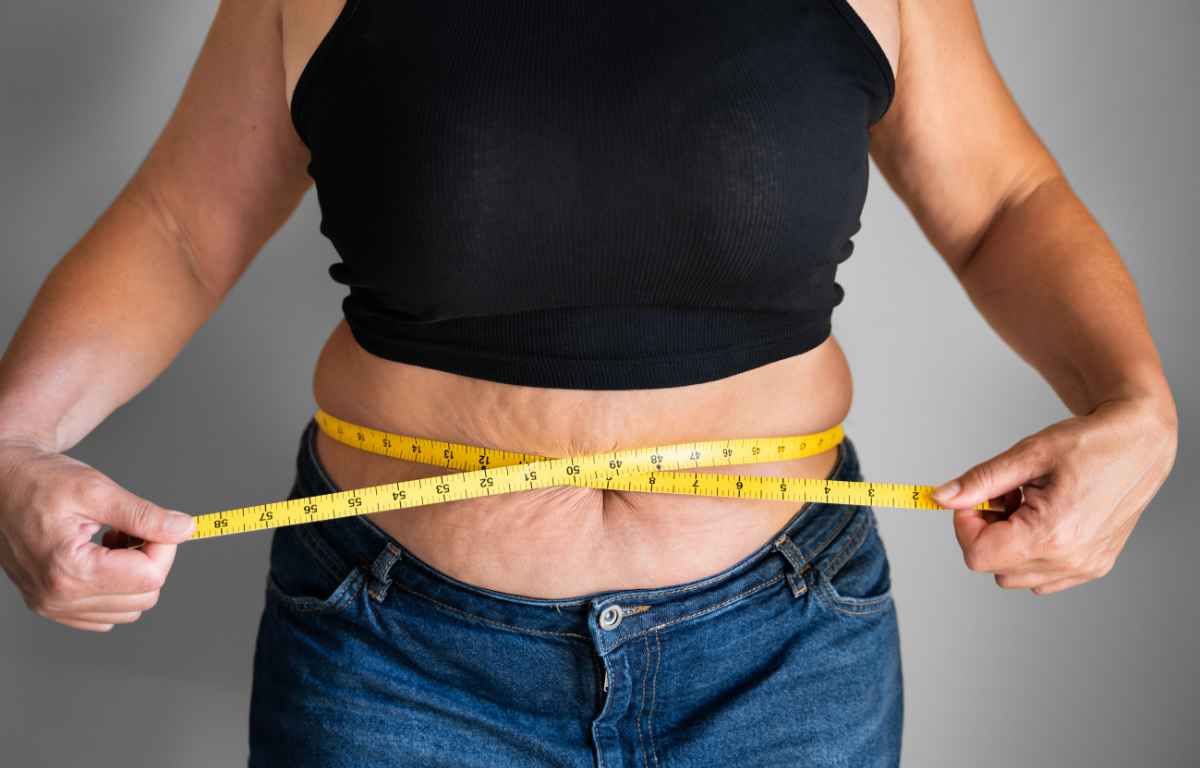
How To Measure Visceral Belly Fat At Home
To check for visceral belly fat at home, take off your top and shoes, stand with your feet together, and grab a tape measure. Relax your stomach muscles, exhale, and place the tape around your waist. The tape should close at your navel and should be the same level as your back.
Now for women, if your results are 31.5 inches (80 cm) or lower, you are in the clear and don’t have to worry but anything above that increases your risk for diseases. For men, 37 inches (94 cm) and below is low risk. Lastly, it’s always a good idea to check your body mass index (BMI) regularly.
This free BMI checker will help you determine if you are overweight, or obese so that you can start making the right lifestyle changes
Dangers Of Visceral Belly Fat
Unlike subcutaneous belly fat, visceral belly fat increases your risk of getting high blood pressure, becoming obese, increases your cholesterol levels, leads to heart disease, and in most cases, can cause type two diabetes. Here is a breakdown of each:
Visceral Belly Fat & High Blood Pressure
So according to this study, women who carry a lot of weight around the abdomen or have a high percentage of visceral belly fat were found to suffer from hypertension (high blood pressure. The same study shows that after they lost weight and visceral fat, their blood pressure went back to normal.
Now although the study targeted women who were going through menopause, other studies show that even overweight or obese children experienced high blood pressure as well.
Visceral Belly Fat & High Cholesterol
This research from Havard University shows that excess visceral fat causes fatty acids to travel through your veins and enter the liver. When this happens, the liver starts to produce blood lipids which lead to higher LDL cholesterol levels and lowers good cholesterol HDL levels.
In most cases though, reducing visceral fat has been shown to also reduce high cholesterol levels which is very encouraging.
Visceral Belly Fat & Heart Disease
According to the European Society Of Cardiology, excess visceral belly fat has been linked to fatal and non-fatal strokes and heart diseases. That’s because visceral fat causes inflammation of the heart vessels and high blood lipids which constricts the heart vessels as well.
When this happens, it can lead to stroke or heart disease. Usually, losing weight and eating healthy along with regular exercise can help reverse symptoms.
Visceral Belly Fat & Type 2 Diabetes
Lastly, you have type 2 diabetes, you see when there is a high amount of visceral fat around the stomach area, it releases a protein that increases insulin resistance. Insulin is a hormone made by the pancreas that helps the body use sugar as energy.
With insulin resistance, the body won’t be able to use up sugar correctly which causes glucose to enter the bloodstream. When this happens, it can lead to type 2 diabetes which is why losing visceral fat is very important.
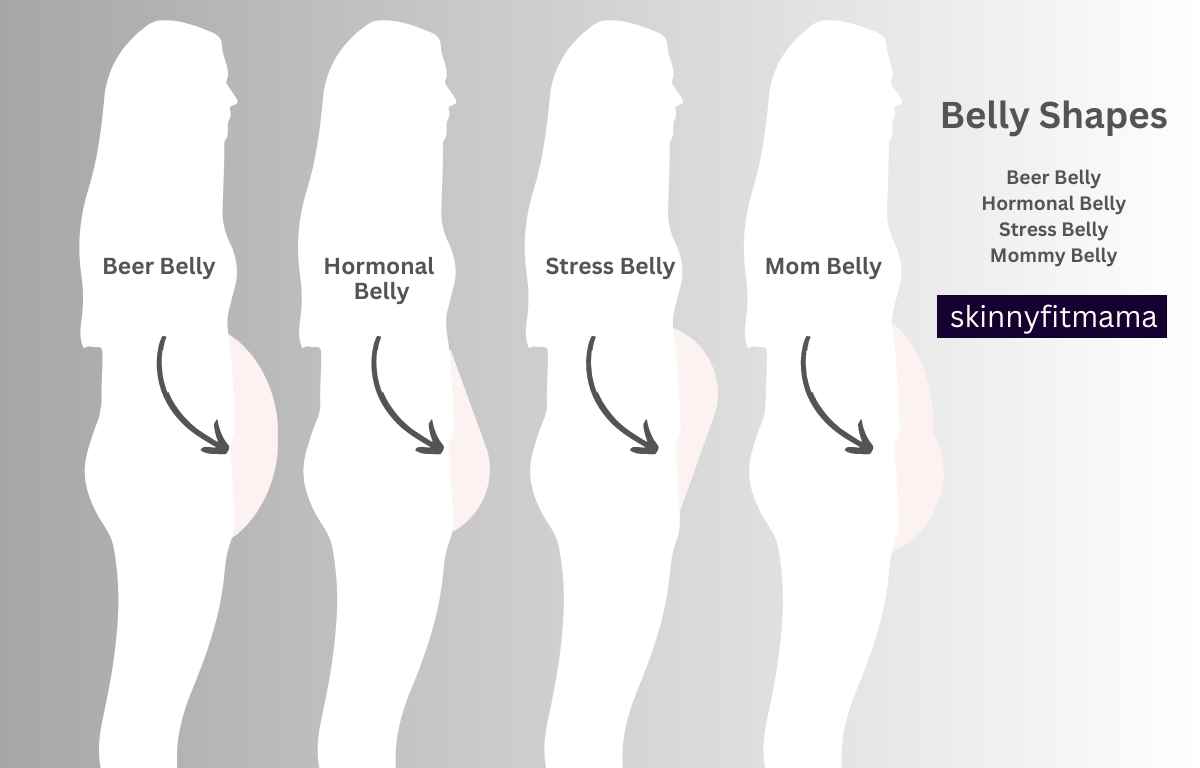
Types Of Belly Shapes & What They Mean
Now that we’ve covered the 2 most common types of belly fat, it’s time to go over the different types of belly shapes and what they mean. The image above helps you decide what kind of belly fat you have just by looking at it and comparing it with yours. Let’s go over each belly shape in the image and see what they mean.
Beer Belly
Beer belly is a type of belly shape that looks round, and large and feels hard to the touch. This type of belly shape is caused by eating too many calories and can also mean that you have a lot of visceral belly fat. In most cases, a beer belly is not caused by drinking beer.
Hormonal Belly
So hormonal belly is the type of belly fat that begins at the bottom and gets smaller at the top. This type of belly shape is caused by hormonal deficiencies and is usually very hard to lose even when on a clean diet and workout plan. When left untreated, the hormonal belly can lead to health problems as well.
Don’t worry though, this research shows taking hormone replacement can reduce hormonal belly. Common health issues associated with hormonal bellies include hypertension, Cushing’s syndrome, and heart problems along with high cholesterol.
Stress Belly
Stress belly usually starts at the top and gets smaller at the bottom, it’s caused by high cortisol levels which are also a stress hormone. In most cases, simply reducing stress, eating healthy, working out, and getting adequate sleep can help you lose your stress belly.
That said, a stressful belly can also lead to visceral belly fat and cause health problems as well so it’s worth getting rid of as well.
Mommy Belly
Lastly, we have mommy’s bellies and unfortunately for us moms, this type of belly fat is actually very hard to get rid of. This is because it’s caused when the muscles in our bellies stretch out to accommodate our little ones. Dieting and exercising can reduce the appearance and tighten the stomach muscles but not completely.
Mommy’s belly has been linked to digestive issues, and pelvic floor health, and reduces our back and core strength.
How To Lose Visceral Belly Fat
Now that we’ve gone over the different types of belly fat and shapes, it’s time to talk about actually losing visceral belly fat! Below are some helpful tips that you can use to melt visceral fat. By using these tips, you will start to feel more healthy, and energetic, plus look amazing.
- 1. Increase foods that speed up the metabolism
- 2. Eat high-fiber vegetables
- 3. Eat high-fiber fruits
- 4. Add more smoothies to your diet
- 5. Start a low-calorie diet
- 6. Avoid foods that cause constipation
- 7. Incorporate 1 hour of aerobics into your daily routine
- 8. Walking for 1 hour 3 times per week helps a lot
- 9. Drink enough water during the day
- 10. Stop eating white sugar, flour, oil, and starch.
Conclusion
Now that you know about the types of belly fat are you going to start trying to lose it? Let me know in the comments below. Also, don’t forget to save this post for later or share it with someone who may find it helpful. Until next time, stay healthy mama!
